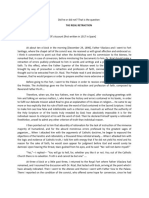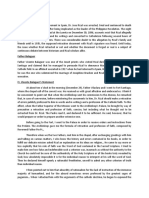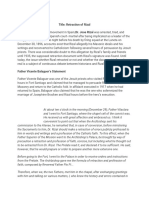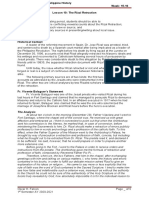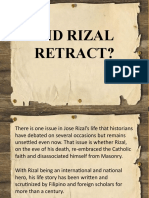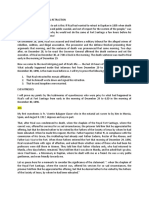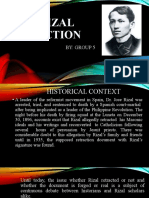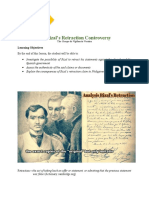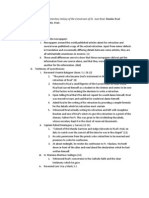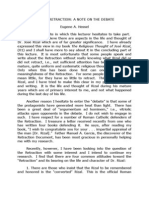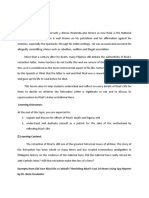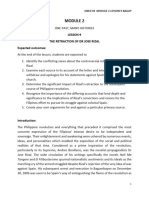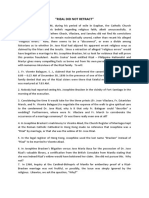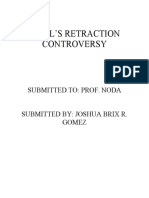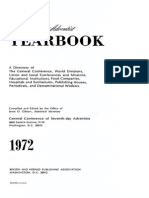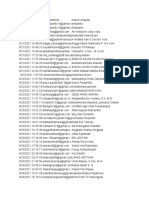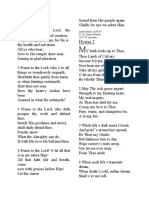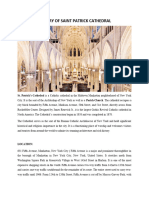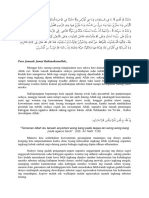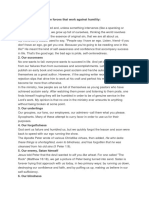Did he or did not?
That is the question
THE RIZAL RETRACTION
FR. VICENTE BALAGUER’s Account [first written in 1917 in Spain]
At about ten o’clock in the morning [December 29, 1896], Father Vilaclara and I went to Fort
Santiago, where the chapel cell of the convict was. He received us with great affection and embraced us.
I think it convenient to point out that when the Archbishop sent his commission to the Ateneo, he
remarked that, in case of conversion, before ministering the Sacraments to him, Dr. Rizal should make a
retraction of errors publicly professed to him in words and writings and a profession of the Catholic
faith. To this effect, when the Father Superior of the Mission went to the Archbishop’s Palace, he
brought by way of precaution a retraction and profession of faith, concise, but including what he
thought out to be extracted from Dr. Rizal. The Prelate read it and declared it to be sufficient. He said,
however, that he would prepare or order to prepare another more extensive one.
Before going to the Fort, I went to the Palace in order to receive orders and instructions from
the Prelate. The Archbishop gave me the formula of retraction and profession of faith, composed by
Reverend Father Pio Pi….
Therefore, when we, the two Fathers, met him in the chapel, after exchanging greetings with
him and talking on various matters, I, who knew the history and errors contained in his books, in order
to fulfil our delicate mission asked Rizal to give an explanation of his ideas on religion…. He came to say
more or less explicitly that his rule of faith was the word of God contained in the Sacred Scripture. I tried
to make him see how false and indefensible such a criterion was, inasmuch as without the authority of
the Holy Scripture or of the books truly revealed by God; how absolutely impossible it is for the
individual reason to interpret at his will the word of God. Then he declared himself openly a rationalist
freethinker, unwell to admit any other criterion of truth than individual reason.
I then pointed out to him that absurdity of rationalism for the lack of instruction of the immense
majority of humankind, and for the absurd monstrous errors professed by the greatest sages of
paganism…. When I attacked him with the arguments of Catholic doctrine, he began to expound the
objections of the heretics and rationalists, a thousand times refuted already…. When I attacked him with
the logic and evidence of Catholic truth, I told him with energy that if he did not yield his mind and his
reason for the sake of faith, he would soon appear for judgment before God and would surely be
damned. Upon hearing this threat, tears gushed from his eyes, and he said: “No I will not damn myself.”
“Yes,”—I replied— “You will go to hell, for, whether you like it or not. Yes; out of the Catholic
Church there is no salvation. Truth is and cannot be but one” ….
At three o’clock or a little past three, I returned to the Royal Fort where Father Vilaclara had
remained, and I resumed the discussion with Dr. Rizal, that lasted until dusk, arriving at the point which I
have already indicated. Then I went to the Ateneo and thence I went with Father Viza to the Palace.
There I reported on the condition of the convict, who offered some hope for conversion, since he had
�asked for the formula of retraction. Hence, I requested the Prelate for the formula he had promised, and
he told me that it was not yet finished. Soon he would send it to me.
I was already night when I arrived at the Fort. I found Dr. Rizal impatient. He asked for the
formula of the Prelate. This came at last, at about ten o’clock; upon knowing it, the convict asked me for
it insistently. Without letting me read it first, he called and asked me to read it to him.
Both of us sat at a desk, where there was stationery, and I began to read it. Upon hearing the
first paragraph, he told me: “Father, do not proceed. That style is different from mine. I cannot sign that
because it should be understood that I am writing it myself.”
I brought out then the shorter and more concise formula of Father Pi. I read the first paragraph
and he said to me: “That style is simple as mine. Don’t bother, Father, to read it all. Dictate what I ought
to profess and express, and I shall write, making in any case some remarks.”
And thus, it was done. As I suggested the idea, he proceeded to write with steady hand and
clear letters, making at times some observation or adding some phrase. Certainly, after the discussion,
Dr. Rizal was yielding to the impulse of grace since he had retired into himself and prayed as he had
promised. Thus, he appeared to be while writing his retraction….
He finished the writing, and thus it remained. It has half past eleven; it was dated December the
twenty-ninth….
This declaration or retraction was signed together with Dr. Rizal by Senor Fresno, Chief of the
Picket, and Senor Moure, Adjutant of the Plaza….
After all these acts… he knelt down of his own accord before the altar of the Virgin, placed in the
chapel cell. In the presence of the Fathers, of the Judge Advocate, of the Chief of the Picket, of the
Adjutant of the Plaza, of three artillery officers, Rizal asked me for his retraction and profession of faith.
He proceeded to read it with pause and devotion….
Of all that has been narrated, I am positive by personal knowledge, I have personally intervened
and witnessed it myself; and I subscribe and confirm it with an oath. And lest, perhaps, someone may
think that I could not remember it with so many details, after twenty years, I testify that on the very day
of Rizal’s death I wrote a very detailed account of everything. The original of this account I have
preserved, and from it I have taken all the data of the present narration.
Before Rizal reached Bagumbayan, I went to the Ateneo and delivered the aforementioned
document to Father Pio Pi, who that very day brought it to the Palace and handed it to Archbishop
Nozaleda.
xxxxxxxxxxxxxxxxxxxxxxxxxxxxxxxx
� Fr. Pio Pi’s Statement [affidavit issued in 1917]
On the eve of the day when Dr. Rizal was put in the chapel, that is, on December the twenty-
eight, I received the commission, which Archbishop Nozaleda entrusted to the Jesuit Fathers, for the
spiritual care of the convict. We accept it most eagerly, not only because it came from the venerable
Prelate, but especially because of its object was to reconcile with God and with the Church, and to save
the soul of him who had our very distinguished and dear pupil. Rizal had always preserved for us, the
Jesuits, a special esteem and affection even after his estrangement from the Church and had rendered
us good service….
Even though I myself, who had not been acquainted personally with Rizal, did not visit him. All
the Fathers who remained with him during his stay in the chapel or who accompanied him to
Bagumbayan, the place of the execution, went there at my request or with my knowledge, and they
kept me informed of all the happenings….
In regard to conversion, at the beginning not a little difficulty was found in convincing and
persuading him. A long discussion, to which he maintained principally with Father Balaguer, became
necessary in order to revive in that soul the faith of old and his Christian sentiments. At last, he
surrendered so willingly and so completely, and the proofs of religiousness and piety were such and so
many that, with much less, the most exacting person would have been satisfied. He was right indeed
when he said, wondering at the change wrought in himself, that he was the Rizal of some time ago, but
another entirely different….
When the retraction was to be subscribed to, he found certain objections in the form of the
composition presented by Father Balaguer, the one sent by the Archbishop. The one which I had made
was shorter although conclusive, and this pleased him. Nevertheless, to make it appear more of his own
and spontaneous, he wished to introduce some little modifications. He wrote it entirely in his own hand
and signed in with a steady hand… Beneath Rizal’s signature, the Chief of the Picket, Juan del Fresno,
and the Adjutant of the Plaza, Eloy Moure, also signed as witnesses.
Not satisfied with signing so explicit an adjuration, Rizal himself, without pressure from anyone,
took into his hands his own document and knelt down before the altar of the chapel. Aloud and slowly,
and even with a certain solemnity, he read his own retraction…
xxxxxxxxxxxxxxxxxxxxxxxxxxxxxxxxxxxxxxx
� Rafael Palma’s Criticisms [from Biografia de Rizal, 1949, chapters 32 and 33]
For the first time in this work, those who should have spoken from the beginning because of
their direct intervention in the act of conversion and retraction of Rizal, speak and confirm in all its parts
the narrative which appeared in 1897 in Rizal y su Obra. That should be conclusive; but that is not. All
the declarations therein cited are those of ecclesiastics and their friends, and it is to be supposed that all
of the latter would not contradict the version given by the former. The only testimony that might be
considered impartial is that of Taviel de Andrade, the defence counsel of Rizal, but his testimony to the
conversion of Rizal is mere hearsay, that is to say, what he heard the priests say, and that diminishes its
value very much.
We must consider the weight and value of these testimonies which to be partial and interested.
We do not ignore the respect that is due to the sacred character of said persons; but as Brutus said,
“You are a friend, but truth is a greater friend.” Lastly, we must consider whether the coetaneous acts
performed by the ecclesiastical authorities or by the government are in accord with the belief that Rizal
had been converted for if they were not, they would not produce the moral evidence that is needed.
Well, then, these acts tend to demonstrate that Rizal was not reconciled with the Catholic
church, judging from the way they treated him after his death. In the first place, the document of
retraction was kept secret so that no one except the authorities was able to see it at that time. Only
copies of it were furnished the newspapers, but, with the exception of one person, nobody saw the
original. In fact, this original was kept in such a way that it was not found until after thirty years had
transpired. In the second place, when the family of Rizal asked for the original of said document or a
copy of it as well as a copy of the certificate of canonical marriage with Josephine Bracken, both
petitions were denied. In the third place, Rizal’s burial was kept secret, the cadaver having been
delivered to the members of a Catholic association friendly to the friars instead of being delivered to the
family, who had claimed it. How is Christian charity applied to one who dies within the Church if not
even the desire of this family to bury him on their own account is respected? In the fourth place, in spite
of what Rizal meant to the Filipinos and of what his conversion meant, no masses were said for his soul
or funeral held by the Catholics. In the fifth place, notwithstanding (the claim) that Rizal was reconciled
with the Church, he was not buried in the Catholic cemetery of Paco but in the ground without any cross
or stone to mark his grave. Only the diligence of the family was able to identify the spot where he was
buried. In the sixth place, the entry in the book burials of the internment of Rizal’s body is not made on
the page with those buried on December 30, 1896, where there were as many as six entries, but on a
special page wherein appear those buried by special orders of the authorities. Thus, Rizal figures on a
page between a man who burned to death and who could not be identified and another who died by
suicide; in other words, he was considered among persons who died impenitent and did not receive
spiritual aid. In the seventh and last place, there was no moral motive for the conversion. The
extraordinary or abnormal acts of a person are always to some reason or rational motive. What was the
motive that could have induced him; to adjure masonry and reconcile himself to the rites of the religion
which he had fought? Did he not realize that to do so was to be a renegade to his own history?
� Rizal was a man of character and he had demonstrated it in his many circumstances of his life.
He was not likely to yield his ideas because his former preceptors and teachers talked to him. They did it
in Dapitan and did not obtain any result.
++++++++
In short, Rizal’s conversion was a pious fraud to make the people believe that that extraordinary
man broke down and succumbed before the Church which he had fought. The Archbishop was
interested in his conversion for political motives, and the Jesuits lent themselves as his instrument. The
example of Rizal would have great resonance in the whole country, and it was necessary to bolster the
drooping prestige of religion with his abjuration. What if Rizal were a man of valour and convictions and
his conversion would be unbelievable? So much the better. The interest of religion was above him. His
aureole of glory had to be done away with if necessary. What did it matter? He was only an indio.
Xxxxxxxxxxxxxxxxxxxxxxxxxxxxxxxxxxxxxxxxxxx
� Austin Coates’s Analysis [done in Rizal: Philippine Nationalist and Martyr, 1956]
The morning after the execution the newspapers of Manila and Madrid recorded the event, and
announced that on the eve of his death, Rizal had retracted his religious errors, adjured freemasonry,
and in the last hours of his life had married Josephine Bracken. In most newspapers the text of a letter of
retraction supposedly written by Rizal was printed in full. By the government, the announcement was
sent to Spanish consulates abroad with the request to obtain for it the widest possible publicity.
Those who had read Rizal’s books or who knew him closely, which at that time meant the family
and his wide circle of personal friends, most of whom were abroad, took one look at the announcement
and dubbed it… an ecclesiastical fraud.
While unquestionably a fraud, however, to suggest that the Archbishop’s announcement was
issued knowingly, or that there was a plot among the higher ecclesiastical authorities to perpetrate a
fraud is going too far. The nature of society within the church, the society of priests, is such as to render
it virtually impossible for such things to happen. When frauds occur, they are not the planned work of
the church as an organization, though this may be what it looks like to outsiders; they are usually the
work of a small man with his own idea; and the Church, if unwittingly it accepts the fraud as genuine,
has to protect him. Rizal believed that there was a strong likelihood of fraud, and that the prime mover
in this would be the friar archbishop. It was the friars who wanted his retraction. But while in the event
Rizal’s intuition did not play him false, there is no evidence to implicate Nozaleda. Along came a small
man with what the Archbishop wanted.
Balaguer had the intelligence to perceive that everything depended on the speed and audacity
with which he declared his success. The Archbishop was waiting for a retraction, hoping for it. When
news of it came, he would announce it immediately, after which it would be too late for any of
Balaguer’s colleagues to gainsay it.
Certainly, there was no signed letter of retraction. Rizal knew too well the damage such a letter
would do him, besides which he believed before God he had nothing to retract….
Finally, there is the minor point that in view of the public disbelief the Archbishop’s statement
provoked, had there been a signed retraction letter it would certainly have been produced for
inspection, particularly to the Rizal family, who asked to see it, and to many of whom—to Teodora
Alonso in particular—it would have been a source of consolation.
Once the execution was over, and Vilaclara and March returned to be faced with Balaguer’s
claims, the fraud was apparent to the Jesuits, but it was already too late to rectify matters.
What appears with complete certainty is that neither Pio Pi y Vidal nor any of the Jesuits of
probity believed that Rizal had retracted and died confessed. Had Vilaclara and March, who were with
Rizal at his execution, been satisfied that there had been a retraction, it is inconceivable that they would
�not have given him Christian burial. The Jesuits had been entrusted by the Archbishop with the spiritual
care of the condemned man; and it was their responsibility, if they were satisfied that he had died
confessed, to see he was decently buried. This the two Jesuits at the execution did not do….
The Rizal family found it difficult to accept either the retraction or the marriage. They knew their
brother; they knew that if he had retracted, he would certainly have so in his 6 a.m. communication to
his mother, knowing the consolation it would have given her.
Difficulties began as disbelief spread, and they were deepened by Balaguer’s urge to elaborate
and to see himself publicly praised. As he affirmed on oath in 1909, he settled down that very night, 29
December, to write his account, in which, since he intended it to be published anonymously, he included
much praise of himself, an aspect which, since he admitted the authorship, renders him a sorry and
rather absurd figure….
Balaguer had in fact damaged the Church’s case. Worse than this, he had unwittingly revealed
his own fraud. In his account, he made no mention of the Ultimo Adios.
That Rizal on the night of the 29 th wished to write verses Balaguer knew; he told a journalist
about it. But when the following morning only letters, books and an alcohol burner remained to be
disposed of by the authorities, he erroneously concluded that no poem had been written and thus made
no mention of it in his account, thereby revealing the truth, which was that he was not within Fort
Santiago during the middle of that last night, and had no knowledge of what was then taking place…
Not only did Balaguer in his account not mention the poem; he made his account so elaborate
that Rizal is allowed no time in which to write; and only a glance at the Ultimo Adios is needed to show
that it would have taken several hours to write….
XXXXXXXXXXXXXXXXXXXXXXXXXXXXXXXXXXXXXXXXXXXXXXXXXXXXXXXXXX
